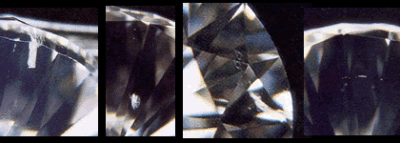WEBSITE HIGHLIGHTS: DESIGNER GALLERY
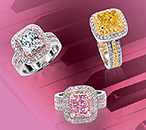 Diamond Source of Virginia is proud to work with a variety of diamond ring and jewelry designers. These companies design and manufacture some of the most beautiful ring settings and diamond jewelry in the country. We encourage you to view their jewelry galleries and see the wide range of designs we are able to provide you.
Diamond Source of Virginia is proud to work with a variety of diamond ring and jewelry designers. These companies design and manufacture some of the most beautiful ring settings and diamond jewelry in the country. We encourage you to view their jewelry galleries and see the wide range of designs we are able to provide you.
DIAMOND SHOPPER MISTAKES: AUTHENTIC GIA GRADING REPORT
![]() Do not confuse GIA Diamond Grading Report with a diamond that has been appraised by a GIA Graduate Gemologist.
Do not confuse GIA Diamond Grading Report with a diamond that has been appraised by a GIA Graduate Gemologist.
Independent grading laboratories like the GIA measure and grade diamonds sent to them by wholesalers and retailers. They provide documents called certifications describing the diamond. Respected grading labs to not sell diamonds since that would be a conflict of interest.
The GIA also educates gemologists but just because a gemologist graduated from the GIA educations program does not mean they are somehow qualified to “certify” a diamond. Many diamond shoppers mistakenly think that just because a person graduated from a GIA class, that their opinion in any way “certifies” a diamond. Ironically, the GIA Graduate Gemologist training is focused on gem identification and grading, but has very little about the cut of the diamond and almost nothing about determining a diamond’s value.
Beware of retailers who issue their own in-house certifications. We can only think of one reason that a retailer would issue their own certification opposed to an independent laboratory certification, and that is so they can exaggerate the color and clarity grades. The result is you are paying for quality that you are not getting in your diamond. In other words, you buy a diamond with paperwork saying it is G/VS2 quality when, in fact, it is I/SI1 quality by GIA standards.
NATURAL PINK DIAMONDS
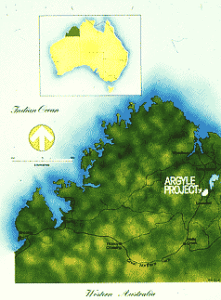 Natural pink diamonds are some of the world’s rarest and highly sought diamonds. The Argyle mine in Australia is the world’s foremost source of unrivalled intense pink diamonds, producing 90% of the world’s supply. However, an extremely small proportion of Argyle Diamonds production is Pink color, in fact less than one tenth of 1% is classified Pink.
Natural pink diamonds are some of the world’s rarest and highly sought diamonds. The Argyle mine in Australia is the world’s foremost source of unrivalled intense pink diamonds, producing 90% of the world’s supply. However, an extremely small proportion of Argyle Diamonds production is Pink color, in fact less than one tenth of 1% is classified Pink.
The pink diamonds of other countries originating pink diamonds (Borneo, India, Brazil and South Africa) are characteristically light in color and pale even further when placed beside the intensely pink Argyle diamonds.
 The Argyle pink diamond comes in shades ranging from delicate pastel rose to robust raspberry and full-blooded purple-reds. The prices per carat are determined by the intensity of color. Argyle selects only its most vibrant pink diamonds for polishing at its head office in Perth. There, the stones are polished in a wide range of cuts, such as round brilliant, marquise, oval and pear, to enhance their natural beauty. Polished pink diamonds are available in the same size ranges as traditional commercial sizes.
The Argyle pink diamond comes in shades ranging from delicate pastel rose to robust raspberry and full-blooded purple-reds. The prices per carat are determined by the intensity of color. Argyle selects only its most vibrant pink diamonds for polishing at its head office in Perth. There, the stones are polished in a wide range of cuts, such as round brilliant, marquise, oval and pear, to enhance their natural beauty. Polished pink diamonds are available in the same size ranges as traditional commercial sizes.
Once a year, Argyle Diamonds issues a special release of outstanding pink diamonds that are sold by special bids in the international and invitation-only, Pink Diamond Tender. Pink diamonds are expensive because they are scarce.
INCLUSIONS & BLEMISHES: FEATHERS
A feather is a general term for any break in a diamond. Cleavage is a break that occurs in a cleavage plane- a week crystal direction along one or more of a diamond’s four octahedral planes. A break in any other direction is called a fracture. Breaks along cleavage planes often have a ribbed or feather-like appearance.
A feather might look shiny and white, glossy, or transparent, depending on the viewing direction. Some feathers catch the light and blink from transparent to bright when you rock the stone. Feathers can present more of a durability problem than any other inclusion because a hard knock can make them larger.
INCREASING DEMAND OUTPACES SUPPLY OF DIAMONDS
Diamond miners are looking forward to a long spell of bumper profits as demand grows in newly-prosperous Asian nations and polishing firms scramble to secure dwindling supplies, analysts say.
 Despite mining few extra gems last year, the value of rough, or uncut diamond production rose over $1 billion (570 million pounds) to some $10.2 billion on some estimates, thanks to a price jump of up to 20 percent.
Despite mining few extra gems last year, the value of rough, or uncut diamond production rose over $1 billion (570 million pounds) to some $10.2 billion on some estimates, thanks to a price jump of up to 20 percent.
The market, at least from the miner’s perspective, is dazzling.
“If we weren’t in the diamond business we would be trying to figure out how to get into it. We like this business probably more than most of the minerals we’re involved in,” said Marcus Randolph, head of diamonds at the world’s biggest diversified miner BHP Billiton.
Figures from De Beers, which produces more than 40 percent of the world’s rough diamonds by value, show sales to the United States rose 8 percent last year and were up 3 percent in Japan — a market that had been stuck in the doldrums for a decade.
China, India and Turkey all recorded double-digit percentage growth in 2004, say South-African based De Beers, whose advertising campaigns are helping to spark consumers’ interest in diamonds across the fast-growing economies of Asia.
In Beijing for example, 80 percent of grooms now buy their brides diamond engagement rings, say De Beers, in a country with no traditional connection between diamonds and weddings. Another De Beers’ campaign, “Trilogy,” promotes three-stone jewelry — representing the past, present and future — where one stone used to be the norm.
“There’s not been a world-class diamond mine discovered for at least 10 years,” says Keith Johnson, head of diamonds at the world’s second biggest miner Rio Tinto, the world’s fourth biggest producer of diamonds. “There are no major greenfield mines in development anywhere in the world. This is the only mineral product where you could say that.”
“On the very worst economic assumptions, you’ve got diamond demand growth of about 5 percent a year and supply growth of half that, so the squeeze can only get worse between now and the end of the decade,” he said.
While production at De Beers’ mines in Botswana — the largest in the world — continues unabated, its new pits planned for Canada will be modest in world terms, says Picton.
Elsewhere, output at Ekati, BHP’s mine in Canada, has tumbled 38 percent in 2004/05, its best days behind it, and the world’s biggest source of small diamonds — Rio’s Argyle mine in Western Australia — may close altogether.
Industry advisers WWW International Diamond Consultants estimate that by 2012 the gap between supply and demand will be worth up to $4 billion at today’s prices.
GEMSTONES: OPAL
Opal is the most colorful of all gems. Its splendid play of color is unsurpassed, and fine examples can be more valuable than diamond. The play of color consists of iridescent color flashes that change with the angle at which the stone is viewed. This phenomenon is often called opalescence. The play of color may consist of large, individual flashes of color (known as schillers), or may be of tiny, dense flashes. The intensity and distribution of the color flashes is a determining factor in the value of an opal.
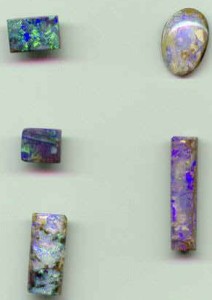 Opal’s color play emanates a very special attraction and fascination. But what causes this phenomenon? This question was impossible to answer for a very long time. Only when in the 1960s a team of Australian scientists analyzed Opals with an electron microscope, it was discovered that small spheres from silica gel caused interference and refraction manifestations, which are responsible for the fantastic play of colors. The spheres, which are arranged in more or less compact structures, succeed in dissecting the light on its passage through the gemstone and turning it into all the colors of the rainbow, always new and always different.
Opal’s color play emanates a very special attraction and fascination. But what causes this phenomenon? This question was impossible to answer for a very long time. Only when in the 1960s a team of Australian scientists analyzed Opals with an electron microscope, it was discovered that small spheres from silica gel caused interference and refraction manifestations, which are responsible for the fantastic play of colors. The spheres, which are arranged in more or less compact structures, succeed in dissecting the light on its passage through the gemstone and turning it into all the colors of the rainbow, always new and always different.
A condition called crazing affects certain opals, causing them to form internal cracks. Crazing is a particularly interesting phenomenon, for it lacks consistency and is unpredictable. Although it can occur at random, it usually strikes when an opal removed from damp conditions is allowed to dry too quickly, or when an opal is exposed to sudden intense light — or a combination of these factors. Crazing may also take place when an opal is subject to vibration, as during the cutting and polishing of a specimen. The severity of the crazing and the time it takes to “craze” varies among specimens. The origin of the specimen is often a determining factor to its resistance to crazing. A very gradual drying process over months or even years can in some cases effectively stabilize the stone and allow it to be cut and polished with a substantially reduced risk of crazing.
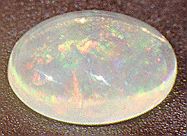 Opals displaying play of color are known as precious opals, and opals lacking play of color are known as common opals. Gems are cut from both the precious and common forms, but precious opal is the primary gem form of this stone. There are many varieties of both precious and common opals. The most desired and beautiful form of opal is black opal, which is opal with a dark blue, dark green, or black background with a strong play of color. Next in importance is white opal, which is opal with a light colored body color (white, yellow, cream, etc.) with strong play of color. Next in line is Mexican fire opal, a transparent to translucent orange red form of common opal. If Mexican fire opals display play of color, they are known as Precious Fire Opal. Many precious opals, besides being classified as either black or white opals, are further classified based on the distribution and habit of their play of color. There are also many variety names given to the numerous forms of both precious opal and common opal. See the opal variety page for an extensive listing of all opal varieties.
Opals displaying play of color are known as precious opals, and opals lacking play of color are known as common opals. Gems are cut from both the precious and common forms, but precious opal is the primary gem form of this stone. There are many varieties of both precious and common opals. The most desired and beautiful form of opal is black opal, which is opal with a dark blue, dark green, or black background with a strong play of color. Next in importance is white opal, which is opal with a light colored body color (white, yellow, cream, etc.) with strong play of color. Next in line is Mexican fire opal, a transparent to translucent orange red form of common opal. If Mexican fire opals display play of color, they are known as Precious Fire Opal. Many precious opals, besides being classified as either black or white opals, are further classified based on the distribution and habit of their play of color. There are also many variety names given to the numerous forms of both precious opal and common opal. See the opal variety page for an extensive listing of all opal varieties.
Australia is the classical Opal country and today is the worldwide most important supplier of Fine Opals. Almost 95 per cent of all Opals come from Australian mines. The remaining five per cent are mined in Mexico, and in Brazil’s north, also in the US states of Idaho and Nevada, but recently the stones have also been found in Ethiopia and in the West African country of Mali.
Opal doublets, often used in jewelry, are thin slices of precious opal glued onto a matrix material. Such gems are considerably cheaper than solid opals, yet provide the same play of color. Opal doublets are sometimes coated with a thin layer or dome of clear Quartz to make them more resistant to scratches (opal is a relatively soft gem). These are known as triplets.
For ages people have believed in the healing power of Opal. It is reported to be able to solve depressions and to help its wearer find the true and real love.

